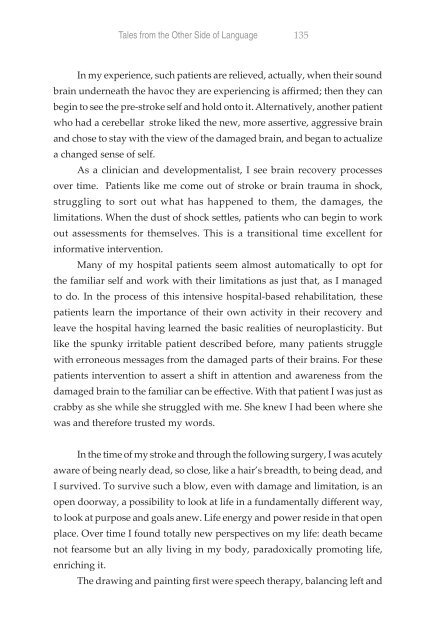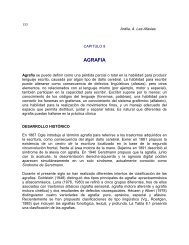the PDF of her book - National Aphasia Association
the PDF of her book - National Aphasia Association
the PDF of her book - National Aphasia Association
Create successful ePaper yourself
Turn your PDF publications into a flip-book with our unique Google optimized e-Paper software.
Tales from <strong>the</strong> O<strong>the</strong>r Side <strong>of</strong> Language 135<br />
In my experience, such patients are relieved, actually, when <strong>the</strong>ir sound<br />
brain underneath <strong>the</strong> havoc <strong>the</strong>y are experiencing is affirmed; <strong>the</strong>n <strong>the</strong>y can<br />
begin to see <strong>the</strong> pre-stroke self and hold onto it. Alternatively, ano<strong>the</strong>r patient<br />
who had a cerebellar stroke liked <strong>the</strong> new, more assertive, aggressive brain<br />
and chose to stay with <strong>the</strong> view <strong>of</strong> <strong>the</strong> damaged brain, and began to actualize<br />
a changed sense <strong>of</strong> self.<br />
As a clinician and developmentalist, I see brain recovery processes<br />
over time. Patients like me come out <strong>of</strong> stroke or brain trauma in shock,<br />
struggling to sort out what has happened to <strong>the</strong>m, <strong>the</strong> damages, <strong>the</strong><br />
limitations. When <strong>the</strong> dust <strong>of</strong> shock settles, patients who can begin to work<br />
out assessments for <strong>the</strong>mselves. This is a transitional time excellent for<br />
informative intervention.<br />
Many <strong>of</strong> my hospital patients seem almost automatically to opt for<br />
<strong>the</strong> familiar self and work with <strong>the</strong>ir limitations as just that, as I managed<br />
to do. In <strong>the</strong> process <strong>of</strong> this intensive hospital-based rehabilitation, <strong>the</strong>se<br />
patients learn <strong>the</strong> importance <strong>of</strong> <strong>the</strong>ir own activity in <strong>the</strong>ir recovery and<br />
leave <strong>the</strong> hospital having learned <strong>the</strong> basic realities <strong>of</strong> neuroplasticity. But<br />
like <strong>the</strong> spunky irritable patient described before, many patients struggle<br />
with erroneous messages from <strong>the</strong> damaged parts <strong>of</strong> <strong>the</strong>ir brains. For <strong>the</strong>se<br />
patients intervention to assert a shift in attention and awareness from <strong>the</strong><br />
damaged brain to <strong>the</strong> familiar can be effective. With that patient I was just as<br />
crabby as she while she struggled with me. She knew I had been w<strong>her</strong>e she<br />
was and <strong>the</strong>refore trusted my words.<br />
In <strong>the</strong> time <strong>of</strong> my stroke and through <strong>the</strong> following surgery, I was acutely<br />
aware <strong>of</strong> being nearly dead, so close, like a hair’s breadth, to being dead, and<br />
I survived. To survive such a blow, even with damage and limitation, is an<br />
open doorway, a possibility to look at life in a fundamentally different way,<br />
to look at purpose and goals anew. Life energy and power reside in that open<br />
place. Over time I found totally new perspectives on my life: death became<br />
not fearsome but an ally living in my body, paradoxically promoting life,<br />
enriching it.<br />
The drawing and painting first were speech <strong>the</strong>rapy, balancing left and



